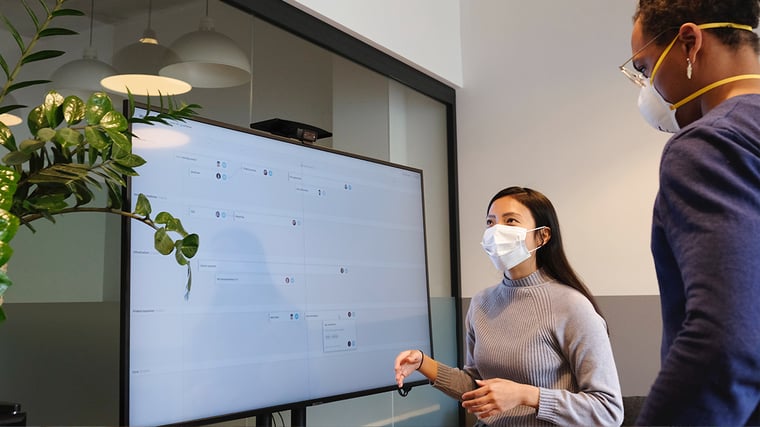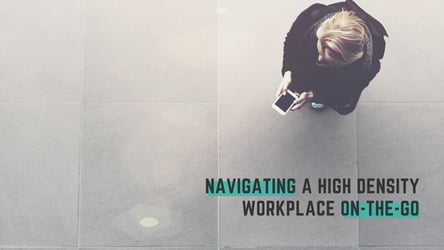Across industries and sectors, organizations are embracing the revolutionary capabilities made possible by the connected workplace. In our recent overview of smart offices, we introduced the concept of bringing people and physical space together in a meaningful way and discussed how these connected workplaces can benefit organizations. In this post, we are going to dive deeper into the foundational technology required to create these smart spaces and address how can you modernize your office and create more efficiencies while reimagining or adjusting your real estate footprint.
What will offices look like post COVID-19?
A post-pandemic office will be purpose-driven and must be designed to serve distributed teams. Offices are no longer the place to go for independent work. When employees come to the office, it will be for a specific reason and they will need to make sure their time is well spent. The technology tools organizations provide to employees will be critical to the success of employees in this new office environment. The ability for employees to collaborate and coordinate their time at the office with others, including desk booking and room reservations, will matter greatly.
We are living in a time that has forced us to reconsider how we use our office space and maximize the technology around us to create more efficiencies for a hybrid workforce. We are not only rebuilding our lives, but we are also inventing new ways to work smarter and more efficiently. We are all collectively looking for more powerful ways to use technology in our offices to keep corporate culture and communication consistent across distributed teams.
From operations and processes to customers and outcomes, IoT-enabled solutions have transformed businesses from every angle and will continue to do so. The IoT ecosystem raises your office's intelligence by integrating smart, often app-based solutions, via the Internet. This creates a host of new possibilities for improving the work environment on all levels.
The benefits of indoor mapping and mobile apps
Increasingly, organizations are turning to smart technology that can help improve the workplace experience and create a more effective and agile environment, which includes a holistic location-aware employee app.
A smart mobile workplace app should provide an open architecture so it can scale across multiple locations and integrate unique services. For example, if your New York office has a work order management system and your London office has a full-scale dining service, they both should be accessible from the same app. The ability to integrate to third-party systems ensures that you get maximum value from your entire real estate portfolio.
CXApp's workplace experience platform and proprietary location technologies give users a complete mobile solution for workplace experience. This powerful combination equips companies with the technology, processes and tools to create smart, innovative and connected workplaces so your team can safely return to the office.
With the ability to integrate with other workplace technologies, leading organizations can leverage IoT solutions to implement location-aware use cases that remove friction and create smart, innovative, and connected workplaces. Smart buildings and intelligent indoor spaces are made possible by bringing together a variety of interactive technologies to connect all aspects of a building and the digital objects within it. Further, building technology is becoming more useful for tenants and property owners. For example, conditioned-based cleaning schedules now focus more on the utilization of the indoor space than static schedules, ultimately decreasing operational costs.
Connected workplace experience applications go far beyond showing users how to navigate from point A to B. They create an environment where location-sensing technologies, IoT devices, and other third-party data and systems are all connected through a single platform to deliver a consumer-like experience in the workplace. With location-aware technologies and dynamic indoor office maps, an individual's location can be established by their proximity to a sensor. This enhanced visibility increases the opportunity for ad-hoc collaboration, helping to make the workspace more efficient and productive.
What can a smart office do?
The pandemic has been an accelerant in forcing companies to reimagine their indoor space and manage distributed teams. Culture is still an important aspect for teams, and companies still need people working together in-person and sometimes side-by-side. For many companies, the most responsible and effective way to manage reopening is by restructuring the way conventional office spaces are used, creating a whole new ecosystem around smart offices. Some of the possible use cases that can result from creating a smart, innovative, and connected workplace include:
- Hot desking
- Enhanced room booking
- Indoor navigation
- Staff visibility
- Occupancy reporting
- Amenities search
- Hot desking
- Visitor management
- Facilities management
- Asset tracking
How location technology works in office environments
If you have used a service like Google Maps or Apple Maps to navigate anywhere, then you've experienced firsthand the power of the wayfinding technology. CXApp provides a similar experience but for the indoor space where Global Positioning Systems (GPS) cannot reach. Location-based services include GPS, Indoor Positioning Systems (IPS), and indoor mapping platforms, as they are among the technologies that allow facilities to visualize location data and deliver location-based services.
While there is no universal standard for IPS, there are a variety of blue dot technologies (BLE, Wi-Fi, RFID, UWB, geomagnetic, ultrasound, etc.) that allow facilities to deliver location-based services. Each IPS solution has its own strengths and weaknesses, so it's important to consult with experts on the technology that is best suited for a building's current and projected needs.
As internet-enabled objects become more pervasive and integrated with location-based services, companies can provide employees with the kind of location-aware solutions that increase operational efficiency and productivity. With integrated IPS, employees can have a more seamless experience including the ability to quickly see the location and status of meeting rooms, book available meeting rooms or workspaces, and search for and navigate to employee desks or meeting rooms.
Gain valuable insights from analytics
Indoor analytics can transform location data into valuable insights by enabling organizations to capture, interpret, and visualize data to uncover key metrics and reports on employee or visitor behavior and movement. Organizations can gain valuable insight to help monitor and optimize campus health and usage and use it to make educated business decisions.
IoT is altering the way people interact with indoor spaces. With the ability to autonomously send and receive data, IoT-enabled devices play a pivotal role in creating smart buildings and intelligent indoor spaces. While offices will continue to be a central location for collaboration, creativity, and networking, the future of work and space management relies heavily on a smart workplace. One that creates a connected culture for smarter, automated experiences for people and the space they utilize.
Schedule a 20-minute consultation to find out how to transform your workplace experience. Our team of experts will review how to implement smart office technologies like office hoteling, hot-desking and more.

.png)

.png)







